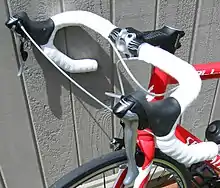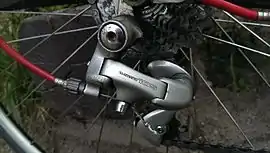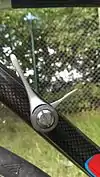 | |
| Type | Public KK |
|---|---|
| TYO: 7309 | |
| Industry | Leisure/Transport |
| Founded | February 1921 |
| Founders | Shozaburo Shimano |
| Headquarters | 3-77 Oimatsu-cho, Sakai-ku, Sakai City, Osaka Prefecture 590-8577, Japan |
Key people | Yozo Shimano (CEO), Taizo Shimano (President) |
| Products |
|
| Revenue | |
Number of employees | 13,000 (2017)[1] |
| Website | Official website |
| Footnotes / references [2][3][4][5] | |
Shimano, Inc. (株式会社シマノ, Kabushiki-gaisha Shimano), originally Shimano Iron Works (島野鐵工所) and later Shimano Industries, Inc. (島野工業株式会社), is a Japanese multinational manufacturing company for cycling components, fishing tackle and rowing equipment, who also produced golf supplies until 2005 and snowboarding gear until 2008. Named after founder Shozaburo Shimano (島野庄三郎, 1894–1958) and headquartered in Sakai, Osaka Prefecture, the company has 32 consolidated and 11 unconsolidated subsidiaries, with the primary manufacturing plants based in Kunshan (China), Malaysia and Singapore.
In 2017, Shimano had net sales of US $3.2 billion, 38% in Europe, 35% in Asia, and 11% in North America. Bicycle components represented 80%, fishing tackle 19%, and other products 0.1%. The company is publicly traded, with 93 million shares of common stock outstanding.[6]
They are also the official neutral support for most of the UCI World Tour.
Cycling
Shimano sales constitute an estimated 70–80% of the global bicycle component market by value.[7] Its products include drivetrain, brake, wheel, and pedal components for road, mountain, track, and hybrid bikes. The components include cranksets comprising cranks and chainrings, bottom brackets, chains, rear chain sprockets and cassettes, front and rear wheel hubs, gear shift levers, brakes, brake levers, cables, and front and rear dérailleurs. Shimano Total Integration (STI) is Shimano's integrated shifter and brake lever combination for road bicycles. The Italian firm Campagnolo as well as US-based SRAM are Shimano's primary competitors in the cycling marketplace.
When the 1970s United States bike boom exceeded the capacity of the European bicycle component manufacturers, Japanese manufacturers SunTour and Shimano rapidly stepped in to fill the void. While both companies provided products for all price ranges of the market, SunTour also focused on refinement of existing systems and designs for higher-end products, while Shimano initially paid more attention to rethinking the basic systems and bringing out innovations such as Positron shifting (a precursor to index shifting) and front freewheel systems at the low end of the market. In the 1980s, with Shimano pushing technical innovation and lower prices, the more traditional European component manufacturers lost significant market presence. During this period, in contrast to the near-universal marketing technique of introducing innovations on the expensive side of the marketplace and relying on consumer demand to emulate early adopters along with economy of scale to bring them into the mass market, Shimano and SunTour (to a lesser extent) introduced new technologies at the lowest end of the bicycle market, using lower cost and often heavier and less durable materials and techniques, only moving them further upmarket if they established themselves in the lower market segments.
In the 1980–1983 period, Shimano introduced three groupsets with "AX" technology: Dura-Ace and 600 (high-end), and Adamas in the low-end. Features of these components include aerodynamic styling, center-pull brakes, brake levers with concealed cables, and ergonomic pedals. By 1985 Shimano introduced innovation only at the highest quality level (Dura-Ace for road bikes and XT for mountain bikes), then trickled the technology down to lower production levels as it became proven and accepted. Innovations include index shifting (known as SIS, Shimano Index System introduced in 1984),[8] freehubs, dual-pivot brakes, 8-9-10-speed drivetrains, and the integration of shifters and brake levers. Also, these components could only work properly when used with other Shimano components; for example, its rear derailleurs have to be used with the correct Shimano gear levers, cables, freehub, and cassette. SunTour tried to catch up, but by the end of the 1980s they had lost the technological and commercial battle, and Shimano had become the largest manufacturer of bicycle components in the world.
 Shimano 600, mid 1980s.
Shimano 600, mid 1980s.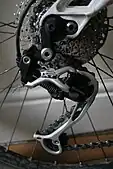 A 2008 Shimano XT rear derailleur.
A 2008 Shimano XT rear derailleur. Ultegra 6500 9-speed road bike components.
Ultegra 6500 9-speed road bike components.
Shimano's marketplace domination that developed in the 1990s quickly led to the perception by some critics that Shimano had become a marketplace bully with monopolistic intentions. This viewpoint was based on the fact that Shimano became oriented towards integrating all of their components with each other, with the result being that if any Shimano components were to be used, then the entire bike would need to be built from matching Shimano components. The alternative perspective is that by controlling the mix of components on the bicycle, a manufacturer such as Shimano can control how well their own product functions. Shimano's primary competitors (Campagnolo and SRAM) also make proprietary designs that limit the opportunity to mix and match componentry.
In 2003 Shimano introduced "Dual Control" to mountain bikes, where the gear shift mechanism is integrated into the brake levers. This development was controversial, as the use of Dual Control integrated shifting for hydraulic disc brakes required using Shimano hydraulic disc brakes, locking competitors out of the premium end of the market. However, with their 2007 product line, Shimano moved back to making separate braking and shifting components fully available in addition to the integrated "Dual Control" components, a move to satisfy riders that wished to use Shimano shifting with other brands of disc brakes.
Shimano in 1990 introduced the Shimano Pedaling Dynamics (SPD) range of clipless pedals and matching shoes, designed so that the shoes could be used for walking. The shoes have a recess in the bottom of the sole for fitting the smaller cleats and therefore it does not protrude, while conventional clipless road pedals are designed for road cycling shoes that have smooth soles with large protruding cleats, which are awkward for walking. The SPD range, in addition to other off-road refinements, was designed to be used with treaded soles that more closely resemble rugged hiking boots. SPD pedals and shoes soon established themselves as the market standard in this sector, although many other manufacturers have developed alternatives that may be less prone to being clogged by mud or easier to adjust. However, the SPD dominance in this sector has meant that alternative pedal manufacturers nearly always design their pedals to be usable with Shimano shoes, and likewise mountain bike shoe manufacturers make their shoes "Shimano SPD" compatible. SPD has spawned two types of road cleats that are incompatible with standard SPD pedals and some shoes – SPD-R and SPD-SL. SPD-R is a now-defunct pedal standard. SPD-SL is basically a copy of the standard Look clipless pedal system. It has a wide, one-sided platform and a triangular cleat that is Look three-bolt compatible.
Shimano products
| Name | Description | |||
|---|---|---|---|---|
| "Shimano Alfine" | The Alfine 700 is an internally geared hub with 8 or 11-speeds, weighing less than 1700 grams (auxiliary components not included). The product was introduced to the market in 2010. It comprises four stepped planetary series offering up to 11-speeds. | |||
| "Biopace" | 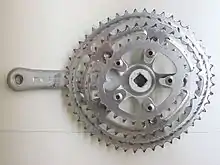 Biopace chainrings. | |||
| "Dyna Drive" | A pedal system with no pedal axle and with the bearings located in the part of the pedal which screws into the crank. This required an oversized hole in the crank 25mm (1" diameter) to accept the Dyna Drive pedals. The theory behind this was to allow the foot to be lower than the pedal axle for better biomechanics. This system was relatively short-lived, one reason being that the pedal bearings wore out quickly. However, they were used by Alexi Grewal (USA) in his gold medal-winning ride in the 1984 Olympic cycling road race in Los Angeles. | |||
| "Freehub" | Shimano introduced a combined rear hub and freewheel in the late 1970s which they named "freehub". But it did not catch on, as its arrangement of internally splined sprockets sliding onto the matching externally splined freehub was incompatible with the then standard separate hub and screw-on freewheel. When a larger number of rear sprockets came to be used, the freehub concept was re-introduced and is now the dominant rear hub type. Freehub style hubs are inherently stronger than screw-on sprocket and freewheel setups because it allows the bearings on the drive side of the hub to sit nearer to the end of the hub axle, reducing bending in the axle caused by chain tension and rider weight, a significant problem leading to fatigue failure in many axles as 6 and 7-speed blocks were introduced. | |||
| "Hollowtech" cranks | These are cranks that are pressure die-cast as tubes open at the pedal end and forged closed before being threaded for the pedals. Previous to this hollow cranks tended to be tubes with a solid part welded to each end to take the pedals and the bottom bracket. | |||
| "Hollowtech II" | This was the next iteration after Hollowtech cranks. For this system, the spindle was fused to the drive side crank arm and the non-drive side crank arm fitted on the splined spindle using pinch bolts. The bottom bracket bearings sat outside the bottom bracket in the frame, allowing the spindle to be a larger diameter, making it stiffer and lighter. The bearing reliability of this system remains quite variable compared to previous Shimano cartridge bottom bracket bearings as Hollowtech II bearing alignment is at the mercy of the alignment of the bottom bracket threads and the facing of the shell rather than the factory set by Shimano in the case of the cartridge BBs. | |||
| "Hyperglide HG" | 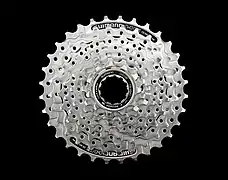 Shimano 8-speed cassette showing the Hyperglide teeth profiles. | |||
| "Interactive Glide" (IG) | Gears feature "pick-up teeth" and specially shaped tooth profiles for smoother and faster shifting. | |||
| Metric chain | Shimano designed chains with a 10 mm pitch instead of the conventional half inch pitch as well as sprockets and chainrings for use with this metric chain; however this did not catch on. For a time 10 mm pitch chains, sprockets, and chainrings were used for motor-paced racing, to reduce the size and weight of the transmission system. | |||
| "Shimano Nexus" | Shimano's family of internally geared hubs. Available in 3-, 7- and 8-speed with or without a coaster brake. The Nexus hubs are comparable in range to a full 16–20-speed system. | |||
| "Servo Wave" | Introduced in the mid-1990s, this system allowed brake levers to pull more brake cable at the start of the lever stroke than at the end. This improved separation between the brake blocks and the rim to accommodate for mud and lack of trueness in the wheels, while still delivering the same braking power like traditional systems. This was implemented initially by mounting the brake cable on a roller that moves towards the lever pivot in a slot in the lever blade as the lever is pulled. A second design pulled the brake cable downwards towards a cam near to the brake lever pivot instead. Servo Wave appeared for the first time on a hydraulic disk brake lever on the 2008 Shimano XT groupset. | |||
| SLR ("Shimano Linear Response") | .jpg.webp) Shimano 600 Tricolor brake caliper (Shimano Ultegra 6400) | |||
| SPD ("Shimano Pedaling Dynamics") | 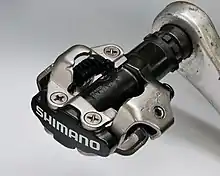 SPD clipless pedal PD-M520 | |||
| STI ("Shimano Total Integration") |
The marketing term for the integration of shifting into the brake levers for road bikes, enabling the rider to shift without taking the hands off the brake levers. This made it possible to shift during uphill passages that require getting out of the saddle and added general convenience for the rider. Although the first generation of STI was unable to downshift multiple cogs which was not a problem in downtube shifters.
| |||
| STePS | 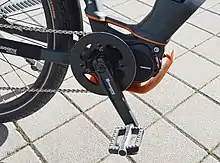 SHIMANO STePS DU-E6100 |
Results
Alexi Grewal used a bicycle equipped with Shimano DynaDrive chainset and pedals (the remainder of the components on his bicycle were primarily Suntour and DiaCompe) to win the 1984 Olympic road race in Los Angeles. In the 1988 Giro d'Italia, Andrew Hampsten rode Shimano to its first Grand Tour victory. In 2002, world championships in both the road and time trial disciplines were won on Shimano equipment. Alberto Contador's 2007 victory in the Tour de France on a Shimano-equipped bicycle represents the first official General Classification victory in that race by a rider using Shimano components (Lance Armstrong originally won the TDF with Shimano in 1999 but was later disqualified due to drug use).[10]
VIA
"VIA" ("Vehicle Inspection Association") is stamped on all Shimano parts. It is an official approval stamp used to certify parts of Japanese vehicles – including bicycles. This mark signifies compliance with certain quality standards.
Road groupsets


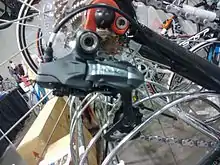
_levers.jpg.webp)
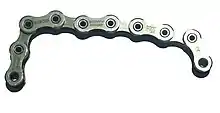
| Groupset | Dura-Ace[11] | Ultegra | 105 | Tiagra | Sora | Claris |
|---|---|---|---|---|---|---|
| 1973 | 'Dura-Ace' introduction (used 'Crane' rear derailleur[12]) No series number | |||||
| 1974 | Shimano-600[13] | |||||
| 1975 | ||||||
| 1976 | Dura-Ace 10 track (later 7000)[13] | |||||
| 1977 | ||||||
| 1978 | Dura-Ace EX (no more 'Crane' RD)[14] - 7200 name added later | 600 EX ('Arabesque') - 6200 name added later | ||||
| 1979 | ||||||
| 1980 | Dura-Ace AX (7300) - 'aerodynamic' sold alongside EX[15] | |||||
| 1981 | 600 AX (6300) 'aerodynamic' sold alongside EX | |||||
| 1982 | ||||||
| 1983 | 600 EX (6207)[16] | 105 'Golden Arrow'[17] | ||||
| 1984 | 7400 : 6-speed and SIS | |||||
| 1985 | 7600 : track | |||||
| 1986 | 600 EX (6208) : 6-speed SIS | |||||
| 1987 | 7400 : 7-speed | 1050 : 6.speed | ||||
| 1988 | 7400 : 8-speed | 600 Ultegra 'Tricolor' (6400) : 7-speed SIS | ||||
| 1989 | updated for 7-speed
(RD-1051, SL-1051) |
|||||
| 1990 | 7400 : STI levers | 1055: renamed to 105SC
7-speed |
||||
| 1991 | ||||||
| 1992 | 600 Ultegra (6402) : 8-speed SIS and STI levers | |||||
| 1993 | FC-7410 low profile crankset FD-7410 front derailleur | 105SC : 8-speed | ||||
| 1994 | ||||||
| 1995 | ||||||
| 1996 | 7700 : 9-speed | |||||
| 1997 | 6500 : Name shortened to just Ultegra : 9-speed | |||||
| 1998 | 25th Anniversary Groupset | |||||
| 1999 | 5500 : 9-speed | |||||
| 2000 | ||||||
| 2001 | 4400 : 9-speed | |||||
| 2002 | 3300 : 8-speed | |||||
| 2003 | 7800 : 10-speed | 2200 | ||||
| 2004 | ||||||
| 2005 | 6600 : 10-speed | |||||
| 2006 | 5600 : 10-speed | 4500 : 9-speed | ||||
| 2007 | ||||||
| 2008 | 7900 : 10-speed | 3400 : 9-speed | ||||
| 2009 | 7970 : 10-speed Di2 | 6700 : 10-speed | 2300 : 8-speed | |||
| 2010 | 5700 : 10-speed | |||||
| 2011 | 6770 : 10-speed Di2 | 4600 : 10-speed | ||||
| 2012 | 9000 : 11-speed
9070 : 11-speed Di2 |
3500 : 9-speed with STI | ||||
| 2013 | 6800 : 11-speed | 2400 : 8-speed | ||||
| 2014 | 6870 : 11-speed Di2 | 5800 : 11-speed[18][19] | ||||
| 2015 | 4700 : 10-speed[20] | |||||
| 2016 | R9100 : 11-speed R9120 : 11-speed, w/ disc brakes R9150 : 11-speed Di2 R9170 : 11-speed Di2, w/ disc brakes | R3000 : 9-speed internal cable routing | ||||
| 2017 | R8000 : 11-speed[21] R8020 : 11-speed, w/ disc brakes R8050 : 11-speed Di2 R8070 : 11-speed Di2, w/ disc brakes | R2000 : 8-speed internal cable routing | ||||
| 2018 | R7000 : 11-speed[22] R7020 : 11-speed, w/ disc brakes | |||||
| 2019 | 4720 : 10-speed, w/ disc brakes[23] | |||||
| 2020 | ||||||
| 2021 | R9250: 12-speed Di2 R9270: 12-speed Di2, w/ disc brakes | R8150: 12-speed Di2 R8170: 12-speed Di2, w/ disc brakes | ||||
| 2022 | R7150: 12-speed Di2, w/ disc brakes [24] | |||||
| 2023 | R7120: 12-speed, w/ disc brakes |
Mountain groupsets
The first Shimano MTB groupset was Deore XT in 1983. It was based on a 1981 Deore derailleur built for touring.
Mountain bike groupsets include:
| groupset | XTR | Saint | Deore XT | SLX | Deore | Alivio | Acera | Altus |
|---|---|---|---|---|---|---|---|---|
| 1983 | M700: 6-speed | |||||||
| 1984 | ||||||||
| 1985 | ||||||||
| 1986 | ||||||||
| 1987 | M730: indexed 6-speed | MT60: 6-speed | ||||||
| 1988 | ||||||||
| 1989 | M732: 7-speed | MT62: 7.speed (Deore II) | M500: 7-speed (Mountain LX) | M450: 6-speed (Exage Mountain) | M350: 6-speed (Exage Trail) | M250: 6-speed (Exage Country) | ||
| 1990 | M735: 7-speed Rapidfire | M650/550: 7-speed (Deore DX/Deore LX) | 500LX: 7-speed (Exage) | 400LX: 7-speed (Exage) | 300LX: 7-speed (Exage) | 200GS: 7-speed | ||
| 1991 | ||||||||
| 1992 | M900: 8-speed rapidfire+ | |||||||
| 1993 | M560 : 7-speed (Deore LX) | M520 : 7-speed (Exage ES) | (discontinued) | M320 : 7-speed (Exage LT) | A10, A20, C10 : 7-speed
C20 : 6-speed | |||
| 1994 | M737: 8-speed | MC30/31 : 7-speed (STX/STX-SE) | MC10/MC11 : 7-speed (Alivio) | (discontinued) | C50 : 6-speed | |||
| 1995 | M910: 8-speed | M565 : 8-speed (Deore LX) | MC32/MC33 : 7-speed (STX/STX-RC) | MC12 : 7-speed | M290 : 7-speed (Acera-X) | C90 : 7-speed | ||
| 1996 | M950: 8-speed | M739: 8-speed | M567 : 8-speed (Deore LX) | MC34/MC36 : 7-speed (STX/STX-RC) | MC14 : 7-speed | |||
| 1997 | M569 : 8-speed (Deore LX) | MC37/MC38 : 7/8-speed (STX/STX-RC) | MC16 : 7-speed | CT92 : 7-speed | ||||
| 1998 | M951: 8-speed | M291 : 7-speed (Acera X) | ||||||
| 1999 | M952 : 9-speed | M750 : 9-speed | M570 : 9-speed (Deore LX) | MC18 : 8-speed | M330 : 8-speed | |||
| 2000 | M510 : 9-speed (Deore) | MC20 : 8-speed | ||||||
| 2001 | ||||||||
| 2002 | M340 : 8-speed | CT95 : 8-speed | ||||||
| 2003 | M960 : 9-speed | M800 : 9-speed | M760 : 9-speed | |||||
| 2004 | M580 : 9-speed (Deore LX) | |||||||
| 2005 | M530 : 9-speed | M410 : 8-speed | ||||||
| 2006 | M970 : 9-speed | M801 : 9-speed | ||||||
| 2007 | M770 : 9-speed | M310 : 8-speed | ||||||
| 2008 | M810 : 9-speed | M660/T660 : 9-speed (SLX/Deore LX) | M360 : 8-speed | |||||
| 2009 | M590 : 9-speed | |||||||
| 2010 | M980 : 10-speed | M773 : 10-speed | M663 : 10-speed | M430 : 9-speed | ||||
| 2011 | M985 : 10-speed | M780/T780 : 10-speed | M593 : 10-speed | M390 : 9-speed | ||||
| 2012 | M986 : 10-speed | M820 : 10-speed | M781/786 : 10-speed | M670/T670 : 10-speed (SLX/Deore LX) | ||||
| 2013 | M610/T610: 10-speed | M370: 9-speed | ||||||
| 2014 | M9000: 11-speed
M9050: 11-speed Di2 |
M4000/T4000: 9-speed | ||||||
| 2015 | M8000: 11-speed | M3000/T3000: 9-speed | ||||||
| 2016 | T8000: 10-speed
M8050: 11-speed Di2 |
M7000: 11-speed | ||||||
| 2017 | M6000/T6000: 10-speed | M2000: 9-speed | ||||||
| 2018 | M9100 : 12-speed New Freehub[25] | |||||||
| 2019 | M8100: 12-speed | M7100: 12-speed | ||||||
| 2020 | M6100: 12-speed
M5100: 11-speed M4100: 10-speed |
M3100: 9-speed | ||||||
| 2021 | ||||||||
| 2022 | ||||||||
| 2023 | M8150: 12-speed Di2 for eMTB |
Other groupsets
Other current and previous groupsets include:
- Capreo [F700] – Groupset designed for small-wheeled bikes such as folders and features a cassette with a 9-tooth sprocket.
- DXR [MX70] – Performance BMX racing component.
- Nexave [C810] – Several sub-groupsets are designed for comfort and commuting bikes, some of which feature internal hub gears and roller brakes.
- Tourney - Lowest-end groupset, a mix of inexpensive components including 6-, 7- and 8-speed.
- Zee [M640] - Lower-priced version of Saint, SLX-performance level.
- GRX [RX800/RX600/RX400] - Gravel cycling specific groupsets intended to be compatible with road groupsets and mountain cassettes.[26]
Groupsets no longer offered include:
- Santé - 1987 (Shimano 5000 : 7-speed) Positioned between Dura Ace and Ultegra 600. Characterized by white paint scheme. [27]
- Exage Action, Exage Sport, Exage Motion - 1988 (Shimano A450) [28]
- RX100 - 1990 (Shimano A550) Comparable to Tiagra [29]
- RSX -1995 (Shimano A410) Positioned below RX100. Replaced by Sora. [30]
- 70GS and 100GS - budget groupsets in 1990-1992
- Hone (M600 : 9-speed) – discontinued in 2008
- Metrea [U5000] – Groupset designed for urban riding, promising reliable performance with clean, simplistic design. Introduced in 2015 and discontinued in 2020.
Fishing
Shimano offers a range of fishing tackles including reels, rods, lines, lures, as well as various fishing accessories, apparels and electronics.[31] Their spinning reels are their best-selling product series in the world.[32]
Manufacturing
Shimano has 13,000 employees (2017). Shimano runs fabrications in Australia, China, Germany, India, Indonesia, Japan, Malaysia, Mexico, the Philippines, Singapore, Taiwan, Thailand, the United Kingdom, the United States, and Vietnam.[33]
Partnerships
Shimano is a founding member of the Global Alliance for EcoMobility, an international partnership that works to promote EcoMobility and thus reduce citizens’ dependency on private motorized vehicles worldwide.[34] The EcoMobility Alliance was founded by a group of leading global organizations on the occasion of the Climate Change Conference in Bali in December 2007.
Sponsorships
Shimano sponsors a wide range of organisations, cycling events and athletes. Some notable sponsees include:
- Tour de France, the most prestigious bicycle race in the world.[35][36]
- Ironman Triathlon, long-distance triathlon races, widely considered one of the most difficult one-day sporting events in the world.[37]
- Jonas Deichmann, a German adventurer, extreme athlete and multiple world record holder.[38]
- Henrique Avancini, one of world’s best mountain bike racers.[39]
- USRowing, the national governing body for the sport of Rowing in the United States.[40]
- Ineos Grenadiers, a British professional cycling team.[41]
Financial results
| Year | 2005 | 2006 | 2007 | 2008 | 2009 | 2010 | 2011 | 2012 | 2013 | 2014 | 2015 | 2016 | 2017 | 2018 | 2019 |
|---|---|---|---|---|---|---|---|---|---|---|---|---|---|---|---|
| Revenue (in $ billion) | 1.8 | 1.8 | 2.3 | 2.5 | 2.0 | 2.1 | 2.2 | 2.5 | 2.8 | 2.8 | 3.1 | 2.8 | 3.0 | 3.2 | 3.37 |
| Operating Margin (%) | 15 | 12.3 | 14.8 | 15 | 11 | - | - | - | - | - | - | - | - | - | |
| Free Cash Flow (in $ million) | 200 | 98 | 252 | 109 | 373 | - | - | - | 261 | 231 | 452 | 297 | 500 | 650 |
See also
References
- ↑ "Rad für die Welt". Archived from the original on 2022-04-10. Retrieved 2022-04-10.
- ↑ "Company Profile". Archived from the original on September 8, 2022. Retrieved August 31, 2018.
- ↑ "Company History". Archived from the original on October 7, 2023. Retrieved August 31, 2018.
- ↑ "Shimano Financial Statements". Bloomberg Businessweek. Archived from the original on August 8, 2014. Retrieved August 3, 2014.
- ↑ "Financial Statement 2017" (PDF). Archived from the original (PDF) on 27 April 2022. Retrieved 11 June 2018.
- ↑ Summary of Consolidated Financial Results for FY2017 (English)
- ↑ "Shimano: Time to Ride". Credit Suisse Equity Research. 24 October 2016. p. 16. Archived from the original on 20 October 2020. Retrieved 12 February 2019.
- ↑ ""Key Events in Shimano History"". Archived from the original on 2023-10-07. Retrieved 2018-08-31.
- ↑ "Home". shimano-steps.com. Archived from the original on 2015-09-13. Retrieved 2020-02-23.
- ↑ "Tour de France Winner Groupsets, Year by Year". Archived from the original on 14 January 2017. Retrieved 3 January 2017.
- ↑ "Dura-Ace History". Cycling-Passion. 4 September 2016. Archived from the original on 9 September 2016. Retrieved 28 July 2016.
- ↑ "Shimano Dura-Ace Light Alloy Bicycle Parts - scan 8". Archived from the original on 2020-10-21. Retrieved 2020-10-20.
- 1 2 "Shimano Bicycle System Components (1977) scan 4". Archived from the original on 2023-03-26. Retrieved 2020-10-20.
- ↑ "Shimano Dura-Ace EX brochure (1978)". Archived from the original on 2020-10-27. Retrieved 2020-10-20.
- ↑ "Vintage Shimano; the 1983 Product Line for Road Bikes". Archived from the original on 2020-10-21. Retrieved 2020-10-20.
- ↑ "Shimano 600 EX catalog (11-1983)". Archived from the original on 2020-10-22. Retrieved 2020-10-20.
- ↑ http://www.yellowjersey.org/SH83H.JPG Archived 2020-10-22 at the Wayback Machine
- ↑ "Shimano 105 5800 2014/15 groupset - first look - Cyclingnews.com". 3 April 2014. Archived from the original on 10 September 2016. Retrieved 3 January 2017.
- ↑ "SHIMAno's new 105 brings top level performance to the widest range of riders". Archived from the original on 2014-04-07. Retrieved 2014-04-05.
- ↑ "Shimano launch Tiagra 4700 groupset". 31 March 2015. Archived from the original on 26 September 2015. Retrieved 3 January 2017.
- ↑ "Shimano launches new Ultegra R8000 groupset". 7 June 2017. Archived from the original on 10 June 2017. Retrieved 8 June 2017.
- ↑ "Shimano Line-up Chart Version 1.8". Archived from the original on 1 April 2018. Retrieved 2 April 2018.
- ↑ "Shimano Tiagra 10sp updated w/ slim ergonomic 4720 disc brakes". 7 May 2019. Archived from the original on 7 May 2019. Retrieved 7 May 2019.
- ↑ "New 105 Di2 12-speed groupset offers electronic shifting at Shimano's lowest price point yet". Bikeradar. Archived from the original on 29 June 2022. Retrieved 29 June 2022.
- ↑ "NEW XTR – Next level MTB Components". www.ridextr.com. Archived from the original on 2018-06-23. Retrieved 2018-06-22.
- ↑ "Shimano GRX: The World's First Dedicated Gravel Component Group". bike.shimano.com. Archived from the original on 2020-08-20. Retrieved 2019-09-15.
- ↑ "Archived copy". Archived from the original on 2022-11-08. Retrieved 2022-11-08.
{{cite web}}: CS1 maint: archived copy as title (link) - ↑ "Archived copy". Archived from the original on 2022-11-08. Retrieved 2022-11-08.
{{cite web}}: CS1 maint: archived copy as title (link) - ↑ "Archived copy". Archived from the original on 2022-11-08. Retrieved 2022-11-08.
{{cite web}}: CS1 maint: archived copy as title (link) - ↑ "Archived copy". Archived from the original on 2022-11-08. Retrieved 2022-11-08.
{{cite web}}: CS1 maint: archived copy as title (link) - ↑ "Fishing: Quality Fishing Tackle by Shimano Fishing Australia". Archived from the original on 4 February 2017. Retrieved 3 January 2017.
- ↑ "Shimano Spinning Reels". 31 August 2018. Archived from the original on 31 August 2018. Retrieved 31 August 2018.
- ↑ Neidhart, Christoph. "Rad für die Welt". Süddeutsche.de (in German). Archived from the original on 2022-04-10. Retrieved 2022-04-10.
- ↑ "EcoMobility". Archived from the original on 12 July 2017. Retrieved 3 January 2017.
- ↑ "Shimano Blue for neutral support at Tour de France". Tour de France 2024. Archived from the original on 2023-12-12. Retrieved 2023-12-12.
- ↑ "Shimano secures Tour de France sponsorship agreement". Insider Sport. 2021-01-21. Archived from the original on 2023-12-12. Retrieved 2023-12-12.
- ↑ "Shimano sponsors global Ironman events". BikeBiz. 2010-05-06. Archived from the original on 2023-12-12. Retrieved 2023-12-12.
- ↑ Scheurer, Béatrice (2023-06-19). "Aedermannsdorf: Das neue Abenteuer von Jonas Deichmann". Solothurner Zeitung (in German). Archived from the original on 2023-10-24. Retrieved 2023-12-12.
- ↑ "This is Home Henrique Avancini". Shimano MTB. Archived from the original on 2023-12-12. Retrieved 2023-12-12.
- ↑ "USRowing Announces Sponsors". USRowing. 2020-12-02. Archived from the original on 2023-12-12. Retrieved 2023-12-12.
- ↑ "Shimano company profile". Global Cycling Network. 2023-06-15. Archived from the original on 2023-11-01. Retrieved 2023-12-12.
- ↑ Wolinsky, Jacob (June 7, 2010). "Shimano Inc". Daily Markets. Archived from the original on 2012-03-18. Retrieved 2013-06-04.
- ↑ "Shimano Inc (7309:Osaka)". Bloomberg Businessweek. Archived from the original on 2014-08-08. Retrieved 2013-06-04.
Currency in Millions of Japanese Yens at 100 JPY per USD for 2009-2012 Revenues = 186,686.0; 213,596.0; 221,770.0; 245,843.0
- ↑ "Annual Financials for Shimano Inc". MarketWatch. Archived from the original on 16 May 2019. Retrieved 20 May 2019.
